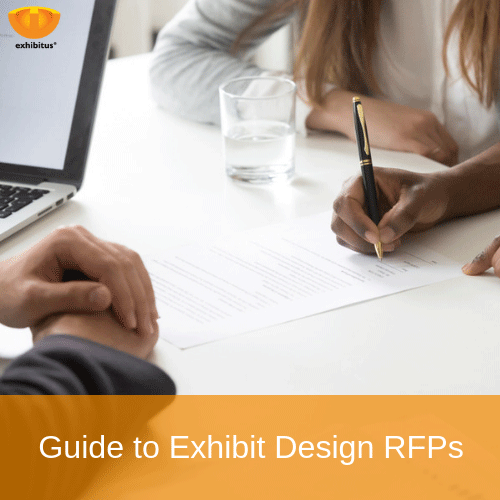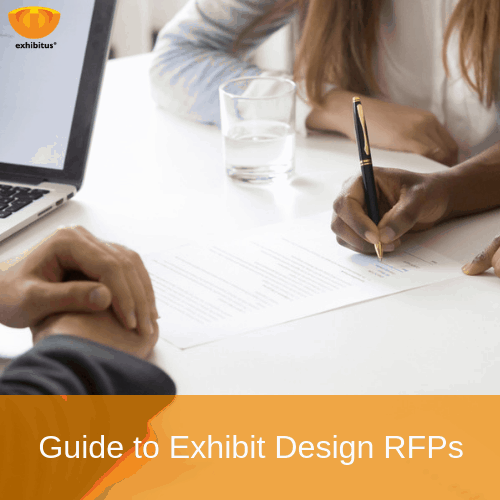
You’ve come to the realization that it is time for a new custom trade show exhibit. Now what? If you’re feeling overwhelmed at the thought of writing a request for proposal (RFP) for the design, engagement and fabrication of an exhibit that will meet your face-to-face marketing objectives, you’re not alone.
To develop an RFP that includes the information an exhibit house needs to produce an engaging design that meets your needs requires an investment of time and cross-company collaboration with other stakeholders. For the exhibit house, without clear direction, they could waste valuable time, as well as money, responding to the RFP. Unfortunately, there is no industry template or standard, so knowing what details to include can be confusing. No wonder, according to Exhibitor Magazine, some exhibit houses only respond to 65 percent of the RFPs they receive.
Don’t let your trade show ROI suffer with poor results. To help you navigate the RFP process, the following guide has been created with you in mind, and contains the ins and outs of writing an exhibit design RFP.
What Is an Exhibit Design RFP?
When you need a new exhibit, a trade show design company will help you align your marketing goals with your new environment. The challenge is deciding which design house best fits your needs and budget. That’s where an RFP comes in.
An RFP is a document that asks potential companies to prove themselves, their track record and their work. They’ll bid against other exhibit houses to provide you with their services. Upon receiving multiple responses, it is up to you and your team to choose the exhibit partner. Reviewing each RFP will help you come to a decision.
What to Look for in a Good Exhibit Design RFP
As previously mentioned, there are many crucial elements to include if you want a great design in return. If you miss the mark, so too will the exhibit, and the time and money spent will be a waste for all involved parties. To help you hit the mark, here are six details to include in your design RFP:
1. Company Information, History and Clients
To begin, an exhibit house needs to know your industry and what type of company you are. You’ll need to provide a broad overview of the company’s objectives and products/services, as well as your competitive position in the market you serve. A good place to start is with your sales and marketing literature. This will give designers a good feel for your company, and it will also ensure your marketing goals and exhibit are cohesive. Here are some ideas for you to review or include in your response:
- Sales pitch, products/services presentations
- Brochures
- Current advertising campaigns and creative
- Annual report
Once the basics are covered, discussing your current clients and ideal customers are just as important. Sharing your client personas with a design house helps them envision who they’re speaking to and targeting with the design and engagement.
2. Design and Build Requirements
This is the bread and butter for your potential exhibit house partner. Provide a detailed explanation of what you want your booth to look like and indicate where the agency should begin by outlining your expectations for this RFP. Are you expecting to begin with inspiration boards, or do you want a complete design rendering with the RFP proposal? Keep in mind putting these items together takes time and money for the designers, so you will need to discuss if there is a price associated with the design concepts. From there, share your requirements on booth design, such as:
- Strengths and weaknesses from previous and/or current exhibits
- Booth elements you currently own and want to keep or refurbish
- Corporate design requirements, e.g. fonts, patterns, color palette, logo, slogans
- Product or service information to influence design
- Size and dimensions for booth
- If you need a flexible booth for varying trade show spaces
- Where your booth will be stored or if you need storage support
The more detail you can provide in this section, the more successful the design.
3. Your Trade Show Program and Goals
List the trade shows in which this exhibit will be used. This will not only direct how quickly the exhibit house needs to work, but also indicates the types of shows you’ll be attending. If you have floor plans for the conferences, be sure to include those as well so designers can see exactly how much space they have to design your exhibit. Again, the more detail you provide, the more successful the design will be.
Make sure you document your goals as they may differ as the year progresses. What exactly do you want to accomplish at each show and across your program? Better branding? More leads? Launch a new product? Detail these goals as best you can to serve as guidelines for the overall success of the intended design.
4. Budget
Some trade show managers hesitate to share their budget with potential design firms because they don’t want to put all their cards on the table. However, full disclosure can help exhibit houses make the most of their resources, as well as your time. Moreover, always ask the design house for a budget range; think of it in terms of a “good,” “better,” “best,” approach. Make sure you discuss payment terms and deposits, and let them know you will expect a line-item budget so you can see exactly where your dollars are going.
One of the biggest decisions a trade show manager has to determine is if they are going to rent or buy a booth, as this greatly impacts the budget. Work with your accounting department to determine if they want the exhibit to be a capital or operational expense. They can tell you what they’re comfortable with when it comes to the “life” of the exhibit in the books.
5. Timeline
In addition to knowing the trade show schedule, agencies need to know how quickly you need the proposal, being mindful to provide enough time for them to execute the RFP well. Create a schedule for when the proposals are due, who to send them to, when you will choose an exhibit house, and ultimately, when negotiations and sign-off will take place. From there, work with your newly chosen partner to set project status meetings, walk-throughs, ship dates and show dates.
6. Trade Show Services
Do you need the agency’s help beyond design? Most exhibit houses provide show services such as shipping, installation, on-site supervision, handling in storage and renting components like furniture. Each company should have a rate sheet for their services. Review this carefully as it will tell you how each rate is determined: hourly, flat fee, by weight, by volume and mark up.
Now you know how to create a top-notch RFP, it’s time to start submitting! Exhibitus is an experienced design firm with award-winning exhibits. Contact us today to get started with the RFP process!

